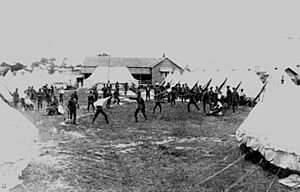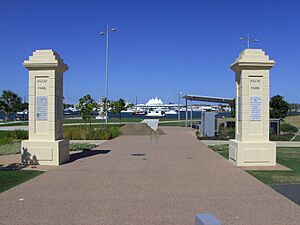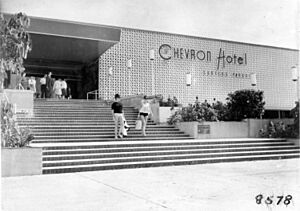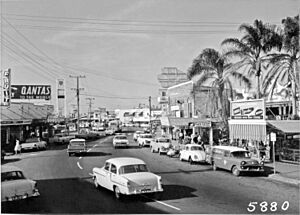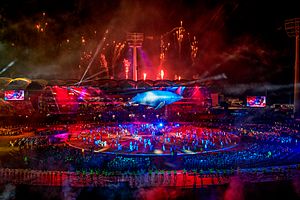History of the Gold Coast, Queensland facts for kids
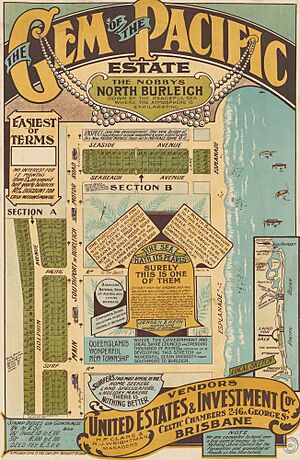
The Gold Coast in Queensland, Australia, has a long and interesting history. People have lived here for at least 23,000 years. European settlers started arriving in the late 1700s. More settlements grew in the 1800s. By 1959, the town officially became a city. Today, the Gold Coast is one of Australia's fastest-growing cities.
Contents
Kombumerri Aboriginal History
Aboriginal people have lived in the Gold Coast area for about 23,000 years. They still live here today. By the early 1700s, several groups lived between the Tweed and Logan Rivers. These groups included the Gugingin, Bullongin, Kombumerri, Minjingbal, Birinburra, Wangerriburra, Mununjali, and Migunberri. Together, they were known as the Kombumerri people. They spoke the Yugambeh language, which had different dialects.
The Kombumerri people were skilled hunters, gatherers, and fishers. They even trained dingos and dolphins to help them. They hunted different animals depending on the season. This included shellfish like pipis, oysters, and mudcrabs. In winter, they caught large schools of fish like sea mullet and tailor. They also ate turtles and sometimes dugong. Parrots, lizards, and bush honey were also part of their diet. Echidnas (spiny Australian animals) and marsupials like koalas and possums were also eaten. Many plants, such as macadamias and Bunya nuts, were used for food and medicine.
The Kombumerri people have a special story called "The Three Brothers." This story tells how three men, Berang-ngehn, Mumuhm, and Yabirahyn, came to this land. They arrived with their families in a large canoe from an island across the sea. A woman on the shore sang a song that caused a storm. The storm broke their canoe, but everyone swam safely to shore. This is how the first people came to this land. The story says that pieces of the canoe can still be seen as rocks in the sea. If you throw a stone and hit a piece, a storm will start, and you will hear the brothers' voices.
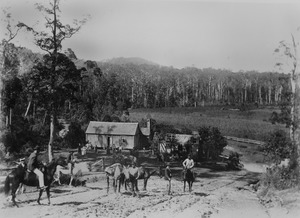
The area near Bundall, close to the Nerang River and Surfers Paradise, was a common meeting place. Tribes from far away, like Grafton and Maryborough, would gather there. Big corroborees (traditional Aboriginal ceremonies) were held. You can still see signs of Aboriginal camps and bora rings (sacred ceremonial grounds) in the Gold Coast and Tweed River areas today. One famous bora ring is at the Jebribillum Bora Park at Burleigh Heads.
As Europeans settled the Gold Coast in the 1800s, they started farms and cut timber. Some people thought the Kombumerri were forced away from their traditional lands. They were moved to missions and Aboriginal reserves. This happened after a law called the Aboriginals Protection and Restriction of the Sale of Opium Act 1897 was passed. This law meant Aboriginal people lost their rights as citizens. They became "wards of the state," meaning the government controlled many parts of their lives.
The state was divided into "Protectorates." A local "Protector of Aboriginals," usually a police officer, managed Aboriginal people's lives. They controlled jobs, wages, and even moved people to reserves. However, many Kombumerri people stayed on their traditional lands. They found work with farmers, oyster producers, and timber cutters. They also worked in sugar and arrowroot mills. They continued their cultural practices and customs as much as they could. Many also worked as servants in wealthy homes.
Because of the strict 1897 Act and later changes, the Kombumerri people kept a low public profile. This helped them avoid being separated from their families or their traditional lands. They have strong spiritual connections to their country. As a result, they kept their cultural practices and language within their own communities.
Early European History
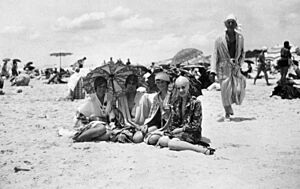
English navigator Captain James Cook was the first European to see the Gold Coast. He sailed past on May 16, 1770. He named Mount Warning (a mountain about 25 km inland) as a warning sign for a dangerous reef. This reef was near a rocky spot he named Point Danger. Captain Matthew Flinders sailed past in 1802. But Europeans did not settle here until 1823. That year, explorer John Oxley landed at Mermaid Beach. He named it after his boat, a cutter called Mermaid. Even though the area appeared on maps early, it only gained attention after surveyors mapped it in 1840.
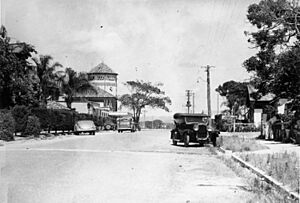
The area's supply of redcedar wood attracted many timber cutters in the mid-1800s. In 1865, the inland town of Nerang was set up as a base for this industry. Nerang means ‘shovel-nosed shark’ in the local Aboriginal language. The nearby valleys and plains quickly became farms for cattle, sugar, and cotton. By 1869, settlements reached the mouth of the Nerang River. The town of Southport was surveyed in 1875.
In 1885, Queensland Governor Musgrave built a holiday home called 'Summer Place'. It was on the banks of the Nerang River near Southport. This made the coastal area popular as a resort for rich people from Brisbane. Summer Place is still there today at The Southport School. It is used as a boarding house for students.
Traveling between Brisbane and Southport was hard because of rough tracks and many creek crossings. But in 1889, a railway line reached Southport. Soon, many guesthouses and hotels were built along the coast.
Many ships ran aground along the Gold Coast in the 1800s. One famous shipwreck was the Scottish Prince. In 1887, this 64-meter-long ship sank while sailing from Scotland to Brisbane. It was carrying whiskey, mousetraps, and linen. Today, only the hull remains. It is covered in corals and sponges and is home to many sea creatures.
The number of people living permanently in the region grew slowly. Then, in 1925, a new coastal road was built between Brisbane and Southport. That same year, Jim Cavill built the Surfers Paradise hotel. It was 2 km south of Southport in an area called Elston. This marked the start of a big tourism boom.
As cars became more reliable in the 1930s, more holidaymakers came from Brisbane. By 1935, most of the coast between Southport and the New South Wales border had houses and hotels. In 1933, Elston residents successfully changed their town's name to Surfers Paradise. The Surfers Paradise hotel burned down in 1936. It was quickly replaced by a grander building with an Art Deco style. It even had a zoo with kangaroos and other wildlife.
The Gold Coast During World War II
The Gold Coast was not attacked during World War II. However, the war still had a big impact, like on most coastal towns. In 1942, American soldiers started arriving. They took over the beach area at Coolangatta to set up rest areas. The Coolangatta Rest Area had five camps for soldiers and two hotels for submariners. These camps were located at Kirra Beach, Kirra Hill, Coolangatta Beach, and Greenmount. They included huts, kitchens, and recreation rooms.
The Royal Australian Air Force also used the Southport Broadwater for seaplanes during World War II. It is not known if they built any permanent structures on land.
Post-War Years and the Name "Gold Coast"
After World War II, the South Coast region became a very popular holiday spot for soldiers returning home.
However, prices for land and other goods became very high. This led to the area being nicknamed the "Gold Coast" starting in 1950. At first, locals thought the name was insulting. But soon, "Gold Coast" became an easy way to talk about the holiday area from Southport to Coolangatta. As tourism grew in the 1950s, local businesses started using the name. On October 23, 1958, the South Coast Town Council was renamed the "Gold Coast Town Council." Less than a year later, the area was declared a city.
Specific Gold Coast areas became favorite holiday spots for people living inland. Coolangatta had a caravan and camping park near the New South Wales border. Many families from Ipswich spent their Christmas holidays there. Later, many holiday rental apartments were built. The connection to Ipswich remains, as the Currumbin Lifesavers share the name 'Vikings' with an Ipswich swimming club. Many Vikings swimmers joined the life saving teams at Currumbin during holidays. Direct flights from Sydney to Coolangatta started in 1956.
The first town planning for the Gold Coast began with the 1953 South Coast Planning Scheme. This plan controlled building heights and focused development in certain areas. By the 1960s, the Gold Coast had much better infrastructure. The local building industry could now build tall holiday apartments and hotels. The first high-rise, Kinkabool, was finished in 1959. Surfers Paradise became the main tourist destination. In 1965, the World water skiing championships were held at the Surfers Paradise Ski Gardens, now known as Sea World. This was the first international event held on the coast.
The boom in high-rise buildings continued in the 1970s. By the time the Gold Coast Airport terminal opened in Coolangatta in 1981, the region was Australia's most famous family holiday spot. Most of the empty land within 10 km of the coast had been developed. Japanese investments in the 1980s made the skyline grow even taller. New theme parks like Dreamworld, Sea World, Warner Bros. Movie World, and Wet'n'Wild Water World were built. These parks made the Gold Coast famous as an international tourist center.
In 1994, the Gold Coast City Council and the Shire of Albert joined together. This created a new local government called the City of Gold Coast Council. The first election for this new council was held on March 11, 1995.
21st Century Gold Coast
By the early 2000s, the Gold Coast was booming with new buildings. This boom reached its peak in 2005 with the opening of Q1. This building in Surfers Paradise was 322.5 meters tall and was the "World's Tallest Residential Tower" at the time.
In September 2010, the Gold Coast Native Title Claim was officially recognized. This decision was made under Australia's Native Title Act 1993. This means that the Yugambeh people are now recognized as important stakeholders in the Gold Coast region. Their rights and interests must be considered in matters affecting their traditional lands.
Notable Historical Figures
- James Cavill, first Gold Coast hotelier
- Eddie Kornhauser, Gold Coast property developer
- Russ Hinze, influential Queensland politician
- Annette Kellerman, Female swimming pioneer
- Johan Meyer, owner of the Meyer's Ferry and the Main Beach Hotel
- Sir Bruce Small, businessman, property developer, mayor of the Gold Coast
See also


